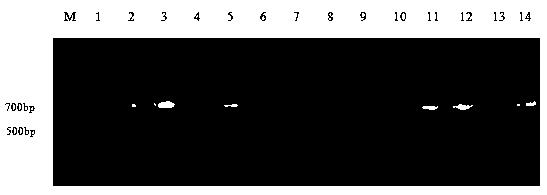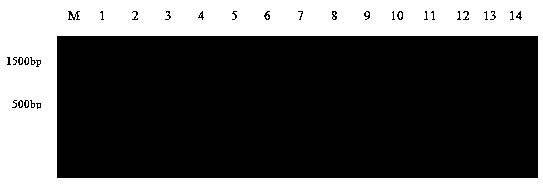Three specific genes capable of generating fumonisins fusarium microspecies and application thereof
A specific gene, fumonisin technology, applied in the field of molecular biology
- Summary
- Abstract
- Description
- Claims
- Application Information
AI Technical Summary
Problems solved by technology
Method used
Image
Examples
example 1
[0040] Example 1: Comparison of whole genomes of three Fusarium races
[0041] In order to perform functional genome comparisons of Fusarium races, considering the availability, representativeness and importance of the data, the strains of Fusarium sp. ET1 were downloaded from the NCBI database (https: / / www.ncbi.nlm.nih.gov . nih.gov / genome / 13188), including gene, protein sequence and gene annotation information. Using the whole genome sequence comparison mGenomeSubtractor online analysis software (http: / / bioinfo-mml.sjtu.edu.cn / mGS / ), the pairwise comparison of the three Fusarium genome sequences (E value is set to 1e -5 ), to screen out specific gene fragments in each race. When the coverage of the protein sequence Blastp of the gene is less than 30%, it is defined as a specific gene.
[0042] After screening, 8 genes were obtained that existed in Fusarium aeruginosa, but did not exist in Fusarium pseudovermitilis and Gibberella fujikura, and had clear gene function annot...
example 2
[0045] Example 2: Acquisition of Race-Specific Genes of Fusarium sp.
[0046] Step 1: Test strains
[0047]The Fusarium sp. used has a wide range of sources, and the strains were collected and isolated from different provinces in China, basically covering the areas where rice ear rot is currently prevalent.
[0048] Step 2: Morphological identification
[0049] According to the shape and growth mode of the megaspore and microspore of the strain, the characteristics of the conidiophores, the growth color of the colony, etc., it was determined to be Fusarium laminarum after morphological identification.
[0050] Step 3: Strain Culture
[0051] Inoculate the strain on potato dextrose agar solid medium (potato 200g, glucose 18g, agar 20g, distilled water 1L, PDA), and take the 5d-grown bacteria block and transfer it into 100mL potato dextrose liquid medium (potato 200g, glucose 18g, distilled water 1L , PDB), after 7 days of shaking culture in a constant temperature shaker at 2...
example 3
[0067] Example 3: Acquisition of Fusarium pseudoverticillium race-specific genes
[0068] Step 1: Test strains
[0069] The Fusarium pseudoverticillium used has a wide range of sources, and the strains were collected and isolated from different provinces in China, basically covering the areas where rice ear rot is currently prevalent.
[0070] Steps 2-5: Same as Example 2, after morphological identification and molecular identification of EF gene, the screened Fusarium pseudoverticillium was used for race-specific gene analysis.
[0071] Step 6: Screening of specific genes of Fusarium pseudoverticillium
[0072] The 12 pairs of specific gene primers in Example 1 were used to design primers for PCR verification. The PCR reaction system is: strain genomic DNA 50ng, forward and reverse primers (10μM) 1μL each, dNTPs (2.5mM) 4μL, 10×PCR buffer 2μL, Taq polymerase (5U / μL) 0.3μL, add ddH 2 O to make up 20 μL. The PCR reaction program was as follows: pre-denaturation at 94°C for ...
PUM
 Login to View More
Login to View More Abstract
Description
Claims
Application Information
 Login to View More
Login to View More - R&D
- Intellectual Property
- Life Sciences
- Materials
- Tech Scout
- Unparalleled Data Quality
- Higher Quality Content
- 60% Fewer Hallucinations
Browse by: Latest US Patents, China's latest patents, Technical Efficacy Thesaurus, Application Domain, Technology Topic, Popular Technical Reports.
© 2025 PatSnap. All rights reserved.Legal|Privacy policy|Modern Slavery Act Transparency Statement|Sitemap|About US| Contact US: help@patsnap.com



